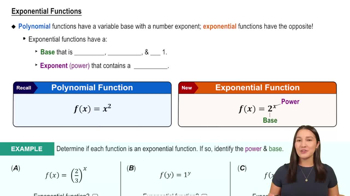Express the radius of a sphere as a function of the sphere’s surface area. Then express the surface area as a function of the volume.
Table of contents
- 0. Functions7h 54m
- Introduction to Functions16m
- Piecewise Functions10m
- Properties of Functions9m
- Common Functions1h 8m
- Transformations5m
- Combining Functions27m
- Exponent rules32m
- Exponential Functions28m
- Logarithmic Functions24m
- Properties of Logarithms36m
- Exponential & Logarithmic Equations35m
- Introduction to Trigonometric Functions38m
- Graphs of Trigonometric Functions44m
- Trigonometric Identities47m
- Inverse Trigonometric Functions48m
- 1. Limits and Continuity2h 2m
- 2. Intro to Derivatives1h 33m
- 3. Techniques of Differentiation3h 18m
- 4. Applications of Derivatives2h 38m
- 5. Graphical Applications of Derivatives6h 2m
- 6. Derivatives of Inverse, Exponential, & Logarithmic Functions2h 37m
- 7. Antiderivatives & Indefinite Integrals1h 26m
- 8. Definite Integrals4h 44m
- 9. Graphical Applications of Integrals2h 27m
- 10. Physics Applications of Integrals 3h 16m
- 11. Integrals of Inverse, Exponential, & Logarithmic Functions2h 31m
- 12. Techniques of Integration7h 41m
- 13. Intro to Differential Equations2h 55m
- 14. Sequences & Series5h 36m
- 15. Power Series2h 19m
- 16. Parametric Equations & Polar Coordinates7h 58m
0. Functions
Introduction to Functions
Problem 1.23
Textbook Question
In Exercises 19–32, find the (a) domain and (b) range.
𝔂 = 2e⁻ˣ - 3
 Verified step by step guidance
Verified step by step guidance1
Step 1: Understand the function given, which is 𝔂 = 2e⁻ˣ - 3. This is an exponential function where the base is e (Euler's number) and the exponent is -x.
Step 2: Determine the domain of the function. The domain of an exponential function is all real numbers because you can substitute any real number for x without restriction. Therefore, the domain is (-∞, ∞).
Step 3: Analyze the behavior of the function to find the range. As x approaches positive infinity, e⁻ˣ approaches 0, making 𝔂 approach -3. As x approaches negative infinity, e⁻ˣ becomes very large, making 𝔂 approach positive infinity.
Step 4: Conclude the range based on the behavior of the function. Since 𝔂 approaches -3 but never actually reaches it, and can increase without bound, the range is (-3, ∞).
Step 5: Summarize the findings: The domain of the function is all real numbers (-∞, ∞), and the range is all real numbers greater than -3, which is (-3, ∞).
 Verified video answer for a similar problem:
Verified video answer for a similar problem:This video solution was recommended by our tutors as helpful for the problem above
Video duration:
3mPlay a video:
Was this helpful?
Key Concepts
Here are the essential concepts you must grasp in order to answer the question correctly.
Domain of a Function
The domain of a function refers to the set of all possible input values (x-values) for which the function is defined. For the function y = 2e⁻ˣ - 3, the exponential function e⁻ˣ is defined for all real numbers, meaning the domain is all real numbers, or (-∞, ∞). Understanding the domain is crucial for determining where the function can be evaluated.
Recommended video:

Finding the Domain and Range of a Graph
Range of a Function
The range of a function is the set of all possible output values (y-values) that the function can produce. For the function y = 2e⁻ˣ - 3, as x approaches infinity, e⁻ˣ approaches 0, making y approach -3. As x approaches negative infinity, y approaches positive infinity. Thus, the range is (-3, ∞). Knowing the range helps in understanding the behavior of the function.
Recommended video:

Finding the Domain and Range of a Graph
Exponential Functions
Exponential functions are mathematical functions of the form f(x) = a * bˣ, where a is a constant, b is a positive real number, and x is the exponent. In the given function y = 2e⁻ˣ - 3, the base e (approximately 2.718) is a natural constant, and the function exhibits rapid growth or decay. Understanding the properties of exponential functions is essential for analyzing their behavior and transformations.
Recommended video:

Exponential Functions

 1:36m
1:36mWatch next
Master Introduction to Calculus Channel with a bite sized video explanation from Patrick
Start learningRelated Videos
Related Practice
Textbook Question
3
views
